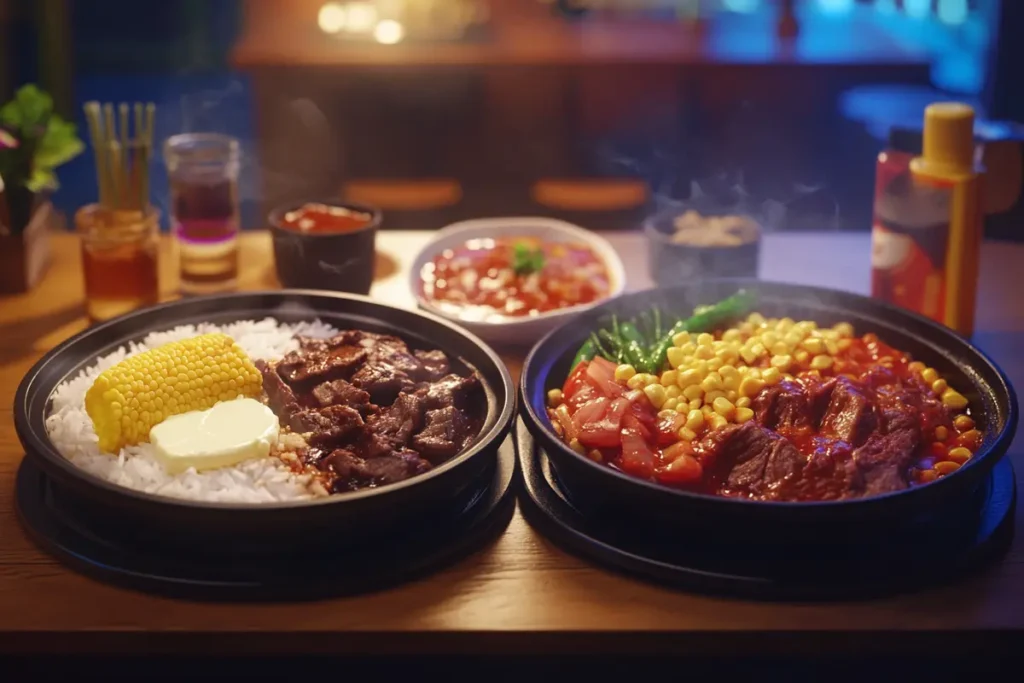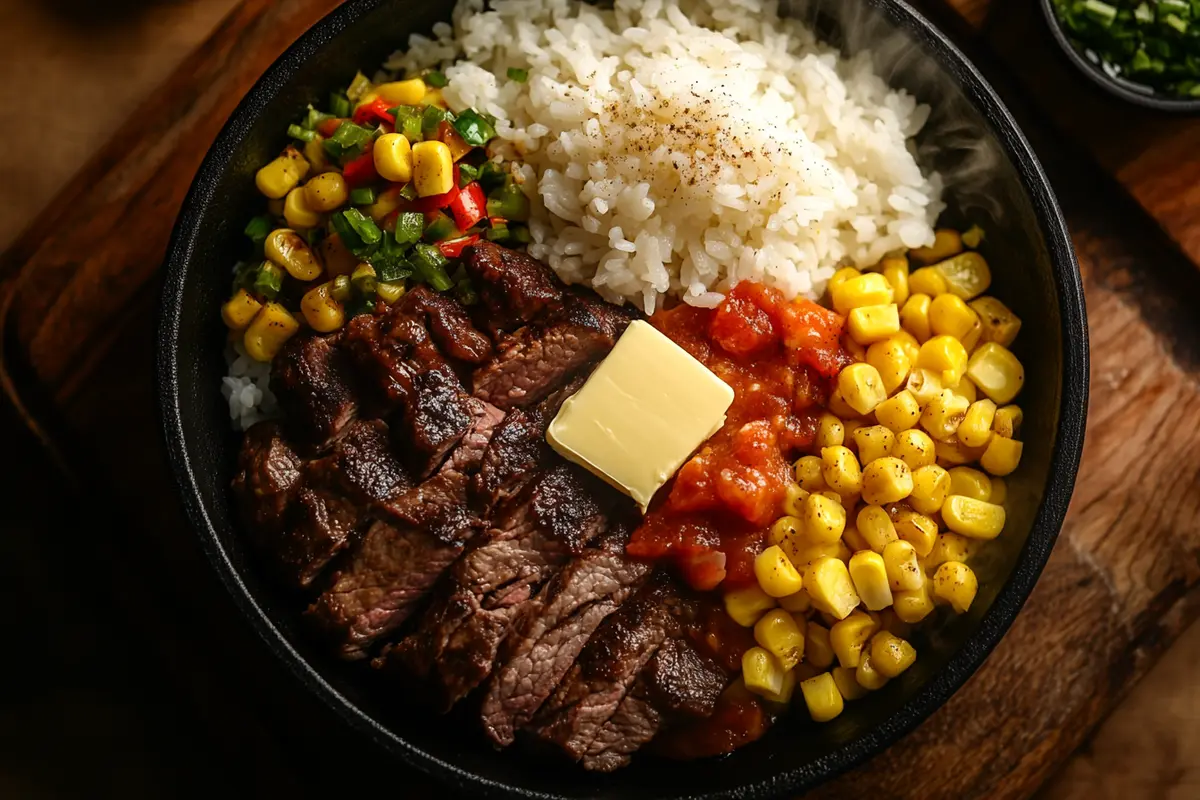Is Pepper Lunch Japanese or Korean? This question often arises among diners curious about the origins of this popular fast-casual restaurant chain. Pepper Lunch features sizzling iron plates, savory sauces, and fresh ingredients delivered in a unique and interactive way. However, many people wonder if the brand’s heritage and culinary approach stem from Japan, Korea, or somewhere else in East Asia.
Understanding the Roots of Pepper Lunch
When you ask, Is Pepper Lunch Japanese or Korean? the straightforward answer is that Pepper Lunch is a Japanese brand. Founded by Japanese chef Kunio Ichinose, Pepper Lunch started in Tokyo during the mid-1990s. The concept emerged from a desire to serve quality, affordable steak meals quickly and efficiently. Therefore, Pepper Lunch established its identity as a Japanese fast-steak restaurant, using a patented iron plate to ensure food cooks evenly at the table.
In Japan, culinary traditions often focus on fresh ingredients, minimal seasoning, and balanced flavors. Pepper Lunch follows these principles by offering simple yet flavorful dishes that let the ingredients shine. By providing sizzling plates topped with rice, thinly sliced meat, and various sauces, Pepper Lunch allows diners to control their own cooking process. This approach draws inspiration from Japan’s teppan-style cooking, which emphasizes direct heat and interactive dining.
The Pepper Lunch Concept and Its Japanese Identity
To further clarify Is Pepper Lunch Japanese or Korean? consider the chain’s culinary DNA. Pepper Lunch’s menu features dishes like Beef Pepper Rice, Curry Beef, and Salmon Pepper Rice. Each meal arrives on a hot iron plate with a pad of butter and pepper to enhance flavor. Diners stir and cook their meal directly at the table. This hands-on method reflects Japanese dining culture, which values interaction and freshness.
In Japan, interactive dining is not limited to Pepper Lunch. Many casual restaurants encourage guests to cook elements of their meal. For example, yakinikus feature grills built into the table, while okonomiyaki shops let patrons flip their own savory pancakes. Pepper Lunch fits neatly into this tradition, offering a quick, modern take on hands-on cooking.
Meanwhile, Korean barbecue restaurants also focus on tableside grilling. This similarity sometimes causes confusion. However, Pepper Lunch’s original concept, menu, and branding are distinctly Japanese. The chain’s simplicity and reliance on quality beef, fresh vegetables, and lightly seasoned sauces align closely with Japanese flavor profiles. Korean barbecue, on the other hand, often involves marinated meats and a variety of banchan (side dishes) that differ from Pepper Lunch’s straightforward approach.
Pepper Lunch vs. Korean Dining: Key Differences
Is Pepper Lunch Japanese or Korean? While Pepper Lunch comes from Japan, understanding differences between Japanese and Korean cuisines helps. Japanese dishes often emphasize subtle umami flavors, delicate balances, and the natural taste of the ingredients. Korean cuisine, however, frequently highlights bold, spicy flavors, fermented elements like kimchi, and a wide array of side dishes.
Pepper Lunch meals generally do not rely on spicy sauces or fermented sides. Instead, the dishes use butter, soy-based sauces, and black pepper to bring out savory notes. The presentation typically involves a single hot plate rather than multiple small dishes. Additionally, Pepper Lunch’s signature pepper rice and sizzling presentation align more closely with Japanese teppan traditions than with Korean grilling methods.

How Pepper Lunch Evolved and Spread Worldwide
When exploring Is Pepper Lunch Japanese or Korean? it helps to consider how the chain expanded. Since its establishment, Pepper Lunch has opened hundreds of outlets in Japan and beyond. Its success encouraged franchising in other parts of Asia, including South Korea, the Philippines, and Southeast Asia. Eventually, Pepper Lunch reached the United States and other Western markets.
This global presence leads to cultural blending. In some countries, Pepper Lunch menus adapt slightly to local tastes. For example, additional sauces or local ingredients may appear. Yet the core cooking method and brand identity remain consistent. The chain’s owners preserve the Japanese essence by maintaining the iron plate concept, fresh ingredients, and minimal seasoning style.
Although Pepper Lunch locations may appear in Korea, that does not change its origin. Instead, the presence in Korea shows that the concept appeals to diners who appreciate a DIY cooking experience. Pepper Lunch’s global popularity comes from its novelty, affordability, and consistent quality rather than from adopting a Korean culinary identity.
Popular Dishes at Pepper Lunch
To understand Is Pepper Lunch Japanese or Korean? and how Pepper Lunch’s Japanese nature influences its menu, let’s consider signature dishes:
- Beef Pepper Rice: Thinly sliced beef served on hot rice with butter, corn, and pepper. Stirring everything together creates a rich, savory flavor.
- Curry Beef Pepper Rice: A Japanese-style curry sauce poured over beef and rice. It highlights Japan’s love for mild, comforting curries.
- Hamburg Steak with Egg: A Japanese take on the hamburger steak, often with a side of vegetables and a soft egg. This dish is common in Japanese family restaurants.
Pepper Lunch’s Place in Japanese Fast-Casual Dining
In Japan, fast-casual dining options abound. Pepper Lunch joined a landscape featuring ramen shops, conveyor-belt sushi, and donburi (rice bowl) establishments. Its founders knew they needed a unique selling point. The idea of serving steak on a hot iron plate at a reasonable price set Pepper Lunch apart.
This concept appealed to busy Japanese diners who valued speed and freshness. Rather than waiting for a steak to be cooked in the kitchen, Pepper Lunch customers could participate in the final cooking steps. The result: a sizzling meal cooked precisely to their liking.
Unlike Korean barbecue restaurants, where the communal experience and many side dishes define the meal, Pepper Lunch targets solo diners and people on the go. Many locations cater to individuals who want a quick, satisfying meal without sacrificing quality. This focus aligns closely with Japan’s fast-paced urban life and high standards for convenience and flavor.
Brand History and Founder’s Vision
To fully answer Is Pepper Lunch Japanese or Korean?, examining the brand’s history helps. Kunio Ichinose, a Japanese chef, founded Pepper Lunch in 1994. He aimed to provide an affordable steak restaurant experience where diners could enjoy premium beef cooked at their table. The patented electromagnetic iron plate system made it possible.
By focusing on freshness and quality, Ichinose tapped into Japan’s culinary ethos. Japanese food culture highly regards seasonal ingredients, balanced tastes, and respectful preparation. Pepper Lunch, although modern and fast, respects these traditions. The brand’s roots and identity trace back to Tokyo’s culinary scene, where the original location gained popularity among locals.
As Pepper Lunch expanded, its Japanese origins remained central to its brand narrative. Promotions, menus, and marketing materials often emphasize the chain’s Tokyo beginnings. This ensures that no matter where Pepper Lunch appears, it carries that Japanese signature.

Comparing Pepper Lunch to Other Japanese Chains
Is Pepper Lunch Japanese or Korean? becomes clearer when you compare it to other famous Japanese chains. Brands like Yoshinoya, known for its beef bowls, or Mos Burger, known for its unique Japanese-style burgers, represent Japan’s approach to fast-casual dining. These chains prioritize simplicity, speed, and distinctive Japanese flavors.
Pepper Lunch sits comfortably among these Japanese brands. Like Yoshinoya, which focuses on thinly sliced beef simmered in a mild sauce over rice, Pepper Lunch also emphasizes beef and rice in a simple format. Although Pepper Lunch adds the twist of tableside cooking, the flavor principles align more with Japanese than Korean traditions.
On the other hand, Korean fast-casual brands might feature spicier dishes or fermented ingredients as staples. Pepper Lunch’s mild seasoning, heavy reliance on pepper, butter, and soy-based sauces differ from the chili-forward profiles common in Korean cuisine. Thus, a direct comparison solidifies its Japanese identity.
Common Misconceptions and Why They Arise
Why might diners ask, Is Pepper Lunch Japanese or Korean? One reason is that Pepper Lunch operates many branches in countries with strong culinary traditions, including South Korea. Seeing a Pepper Lunch restaurant abroad can confuse consumers who assume local origins.
In addition, the tabletop cooking style may cause misconceptions. Many diners associate cooking at the table with Korean barbecue. Although both cuisines use heat at the table, their flavors and techniques differ. Pepper Lunch primarily revolves around a single iron plate and simpler seasoning. Korean barbecue often involves marinated meats cooked over charcoal or gas grills, served with numerous side dishes.
Global branding also plays a role. Pepper Lunch menus, signs, and marketing materials sometimes feature local languages and adapt design elements. This localization helps appeal to consumers abroad. However, this adaptation can muddy the waters about the chain’s true origin.
Pepper Lunch in the Global Market
As Pepper Lunch grew beyond Japan, the brand gained fans worldwide. Countries like the Philippines embraced it, and the chain expanded throughout Asia, North America, and beyond. This global exposure introduces new customers who might wonder about its roots.
For example, American diners encountering Pepper Lunch might think it’s a new fusion concept blending Japanese and Korean elements. However, by understanding its history and menu, the Japanese origin becomes evident. Indeed, Pepper Lunch shares more DNA with Japanese fast-food concepts than with Korean dining styles.
Expansion also means menus adapt. In some places, Pepper Lunch might add region-specific sauces or side dishes. However, the chain consistently maintains its core identity. Thus, even global adaptations do not alter the chain’s Japanese origin.
Key Aspects That Confirm Its Japanese Origin
When uncertain about Is Pepper Lunch Japanese or Korean? look at key aspects that confirm its heritage:
- Founding Chef: The founder is Japanese, and the brand started in Tokyo.
- Culinary Style: The menu uses mild seasoning, focusing on the natural flavors of meat and rice.
- Cooking Method: The hot iron plate concept draws on Japanese teppan traditions.
- Global Branding: Even after international expansion, the company presents itself as a Japanese brand.
These points consistently highlight that Pepper Lunch’s roots and identity are Japanese. Although the chain has grown internationally, it never claims Korean heritage. Instead, it celebrates its Tokyo beginnings and Japanese food culture.
Differences in Ingredients and Sauces
Consider the core ingredients used at Pepper Lunch to reinforce the answer to Is Pepper Lunch Japanese or Korean? The brand relies on thinly sliced, high-quality meats, butter, sweet corn, and a light soy-based sauce. Sometimes, it includes Japanese curry sauce, which is mild and slightly sweet.
In contrast, Korean sauces often feature gochujang (fermented chili paste), soy sauce blends, sesame oil, garlic, and sugar. Korean seasoning tends toward bolder, spicier profiles. Pepper Lunch rarely uses such strong flavors. Its reliance on a butter-pepper base and mild sauces reflects Japanese palates.
The presence of corn as a topping also leans Japanese. Corn is popular in various Japanese dishes, from ramen to pizza. Pepper Lunch uses it to add sweetness and texture, aligning with local tastes. Meanwhile, Korean side dishes often include kimchi or pickled vegetables, which Pepper Lunch does not serve as a standard component.
Pepper Lunch’s Visual and Branding Cues
Branding provides another lens for understanding Is Pepper Lunch Japanese or Korean? Pepper Lunch’s logo and marketing materials often feature simple designs, bright colors, and straightforward messaging. Japanese branding tends to value clarity and simplicity. Store layouts are functional and efficient, mirroring Japan’s approach to restaurant design.
Korean restaurants, while also modern, often emphasize communal dining and social interaction over individuality. Pepper Lunch caters to the single diner or small groups who want a fast, hot meal. This focus on efficiency and personal control over the cooking process feels more Japanese in spirit.
Additionally, Japanese restaurants often emphasize seasonal freshness and highlight the origin of their ingredients. While Pepper Lunch is not explicitly seasonal, it does maintain a focus on quality meat and rice. This focus aligns with Japanese consumer expectations.
Cultural Context: Japanese vs. Korean Cuisine
Cultural context can help address Is Pepper Lunch Japanese or Korean? Japanese cuisine emphasizes subtlety, balance, and seasonal ingredients. Korean cuisine emphasizes strong flavors, fermentation, and communal dining experiences. Pepper Lunch’s format, seasoning, and presentation align closely with Japanese principles rather than Korean.
In Japan, the concept of omotenashi, or considerate hospitality, influences how food is served. Pepper Lunch offers a unique, interactive experience while still ensuring diners get a quick, satisfying meal. This blend of efficiency and enjoyment echoes Japanese hospitality, where convenience and respect for the customer’s preferences intersect.
In Korea, while there is tremendous hospitality, the presentation often involves a range of small dishes that encourage sharing and communal enjoyment. Pepper Lunch focuses on one main dish, placing control in the diner’s hands. This individualistic approach leans toward Japanese-style dining where personal preference is key.
Frequently Asked Questions
Where does Pepper Lunch come from?
Pepper Lunch originated in Tokyo, Japan. It was founded by a Japanese chef who wanted to create an affordable, interactive steak experience. Although Pepper Lunch has expanded worldwide, its roots remain in Japan’s culinary scene.
Is there Pepper Lunch in the US?
Yes, Pepper Lunch has opened locations in the United States. Diners in several major American cities can enjoy the chain’s sizzling plates. This global expansion offers U.S.-based customers a chance to experience a Japanese-style fast-casual concept that stands out from other options.
Who owns Pepper Lunch PH?
Pepper Lunch in the Philippines operates under a franchise system. Local franchisees manage these branches while adhering to the brand’s strict standards. Although owned by local partners, these locations still reflect Pepper Lunch’s original Japanese identity and core dining principles.

